NHS & Equality Act: Diversity and Fair Treatment Analysis Report
VerifiedAdded on 2023/06/10
|9
|2902
|92
Report
AI Summary
This report provides an analysis of equality, diversity, and fair treatment within the National Health Service (NHS) in the UK, focusing on the impact of the Equality Act 2010 and other relevant legislation such as the Employment Rights Act. It examines gender inequality as a protected characteristic within the NHS, emphasizing the importance of fair treatment and equal opportunities for all employees. The report discusses the benefits of promoting equality and diversity in the workplace, including talent acquisition, employee confidence, positive exposure, and cost reduction. It further explores various acts and commissions designed to protect employee rights and ensure compliance with equality standards in the health service sector, addressing issues such as gender pay gaps and discrimination based on age, disability, gender, race, religion, and sexual orientation. The analysis also covers the duties of care required by health service organizations to prevent discrimination, harassment, and victimization, as well as to provide reasonable adjustments for employees with disabilities and flexible working arrangements for parents.
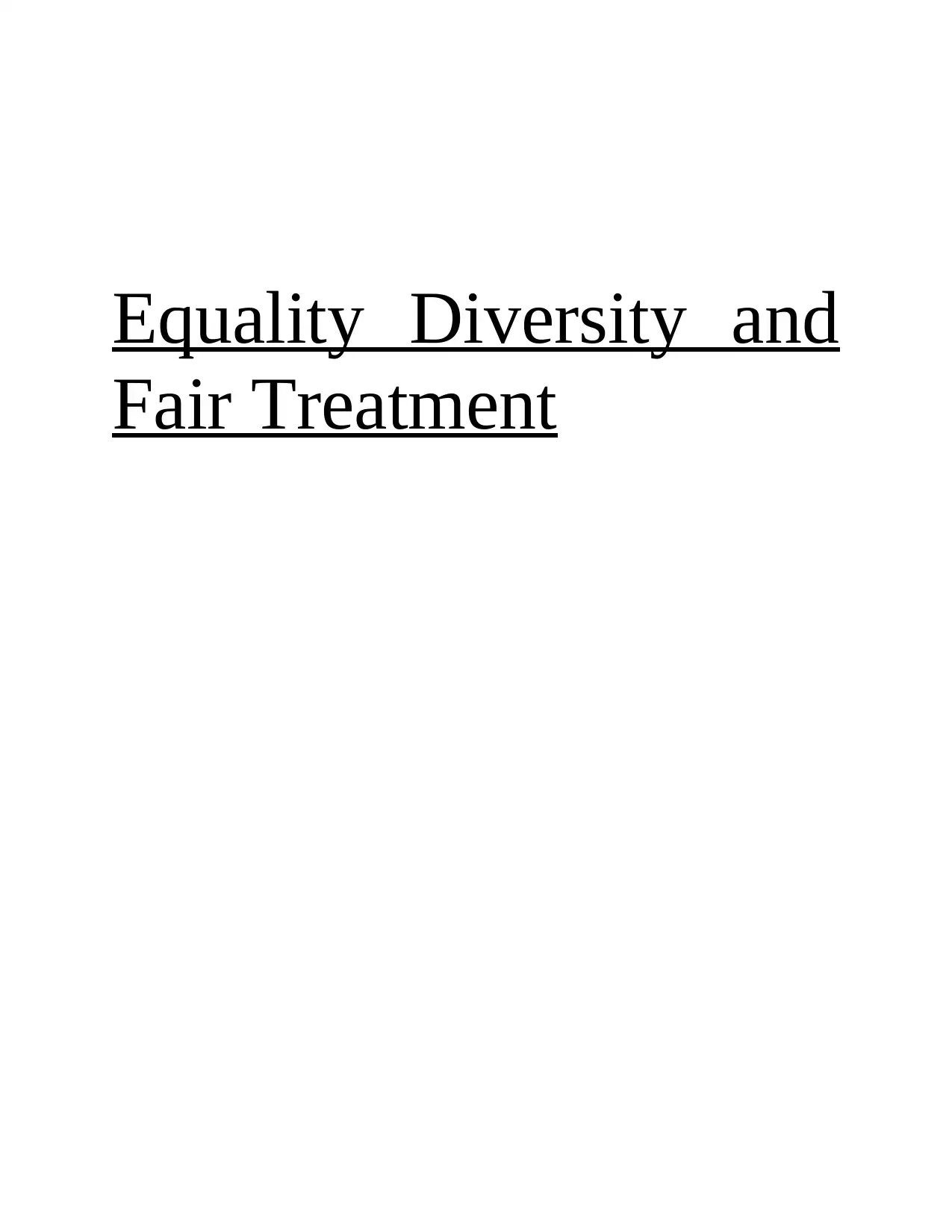
Equality Diversity and
Fair Treatment
Fair Treatment
Paraphrase This Document
Need a fresh take? Get an instant paraphrase of this document with our AI Paraphraser
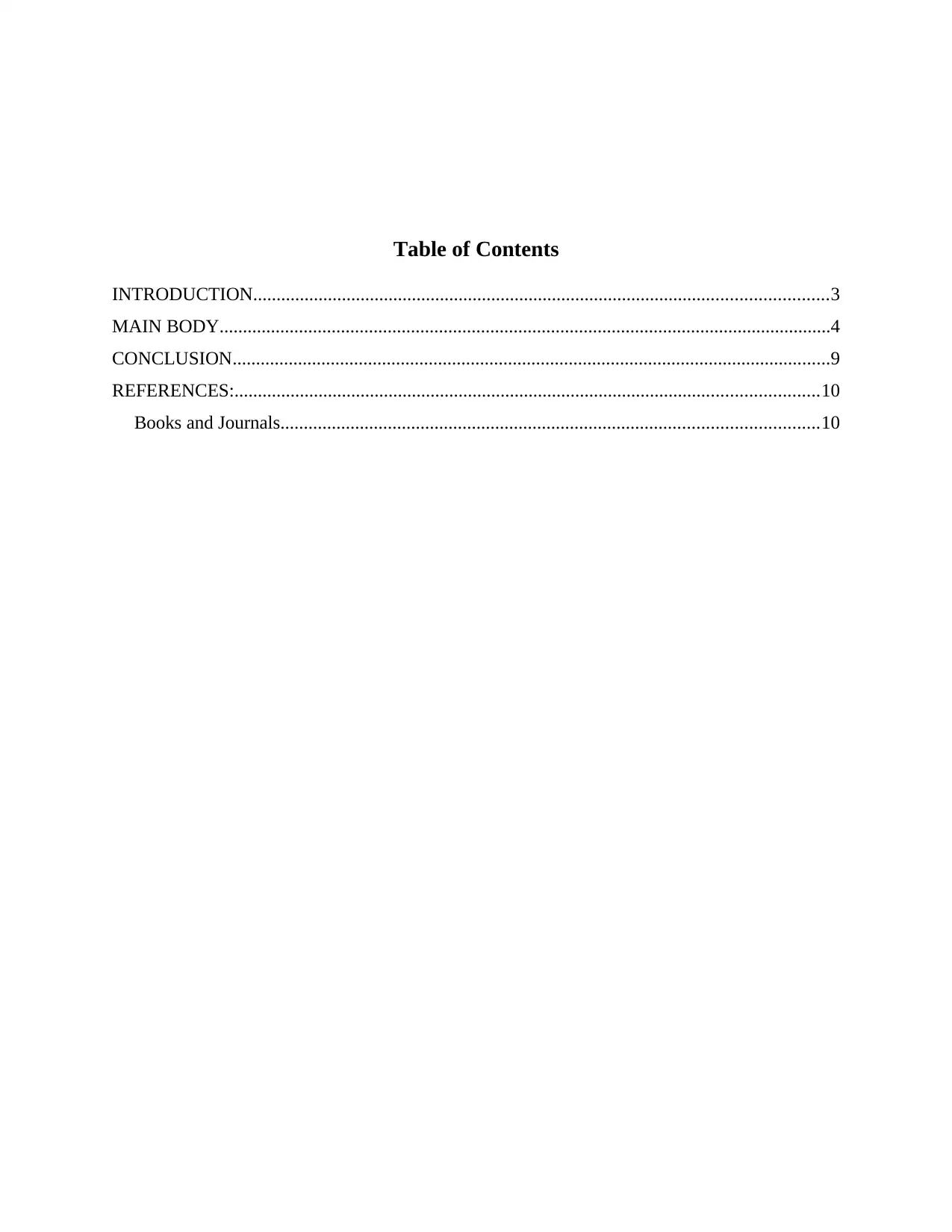
Table of Contents
INTRODUCTION...........................................................................................................................3
MAIN BODY...................................................................................................................................4
CONCLUSION................................................................................................................................9
REFERENCES:.............................................................................................................................10
Books and Journals...................................................................................................................10
INTRODUCTION...........................................................................................................................3
MAIN BODY...................................................................................................................................4
CONCLUSION................................................................................................................................9
REFERENCES:.............................................................................................................................10
Books and Journals...................................................................................................................10
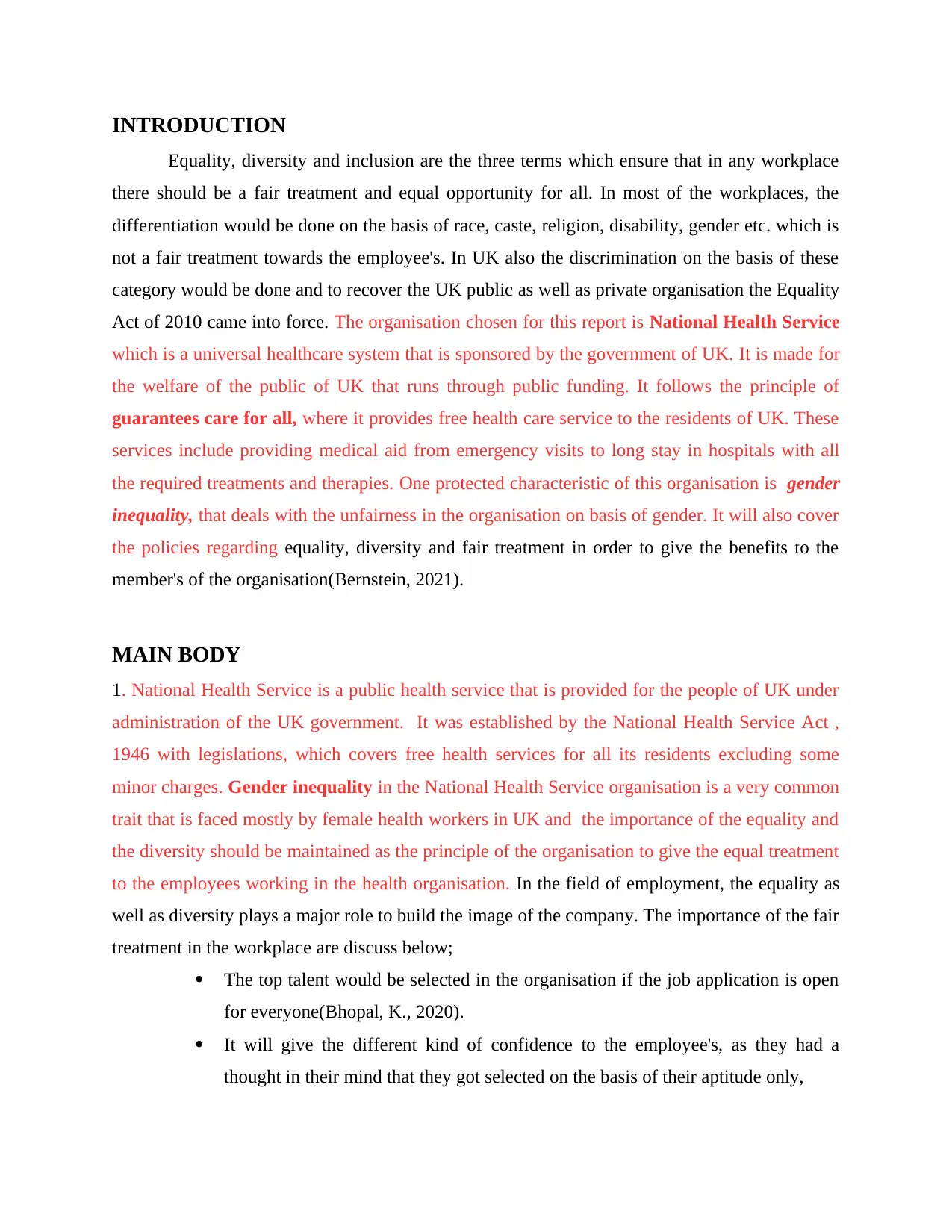
INTRODUCTION
Equality, diversity and inclusion are the three terms which ensure that in any workplace
there should be a fair treatment and equal opportunity for all. In most of the workplaces, the
differentiation would be done on the basis of race, caste, religion, disability, gender etc. which is
not a fair treatment towards the employee's. In UK also the discrimination on the basis of these
category would be done and to recover the UK public as well as private organisation the Equality
Act of 2010 came into force. The organisation chosen for this report is National Health Service
which is a universal healthcare system that is sponsored by the government of UK. It is made for
the welfare of the public of UK that runs through public funding. It follows the principle of
guarantees care for all, where it provides free health care service to the residents of UK. These
services include providing medical aid from emergency visits to long stay in hospitals with all
the required treatments and therapies. One protected characteristic of this organisation is gender
inequality, that deals with the unfairness in the organisation on basis of gender. It will also cover
the policies regarding equality, diversity and fair treatment in order to give the benefits to the
member's of the organisation(Bernstein, 2021).
MAIN BODY
1. National Health Service is a public health service that is provided for the people of UK under
administration of the UK government. It was established by the National Health Service Act ,
1946 with legislations, which covers free health services for all its residents excluding some
minor charges. Gender inequality in the National Health Service organisation is a very common
trait that is faced mostly by female health workers in UK and the importance of the equality and
the diversity should be maintained as the principle of the organisation to give the equal treatment
to the employees working in the health organisation. In the field of employment, the equality as
well as diversity plays a major role to build the image of the company. The importance of the fair
treatment in the workplace are discuss below;
The top talent would be selected in the organisation if the job application is open
for everyone(Bhopal, K., 2020).
It will give the different kind of confidence to the employee's, as they had a
thought in their mind that they got selected on the basis of their aptitude only,
Equality, diversity and inclusion are the three terms which ensure that in any workplace
there should be a fair treatment and equal opportunity for all. In most of the workplaces, the
differentiation would be done on the basis of race, caste, religion, disability, gender etc. which is
not a fair treatment towards the employee's. In UK also the discrimination on the basis of these
category would be done and to recover the UK public as well as private organisation the Equality
Act of 2010 came into force. The organisation chosen for this report is National Health Service
which is a universal healthcare system that is sponsored by the government of UK. It is made for
the welfare of the public of UK that runs through public funding. It follows the principle of
guarantees care for all, where it provides free health care service to the residents of UK. These
services include providing medical aid from emergency visits to long stay in hospitals with all
the required treatments and therapies. One protected characteristic of this organisation is gender
inequality, that deals with the unfairness in the organisation on basis of gender. It will also cover
the policies regarding equality, diversity and fair treatment in order to give the benefits to the
member's of the organisation(Bernstein, 2021).
MAIN BODY
1. National Health Service is a public health service that is provided for the people of UK under
administration of the UK government. It was established by the National Health Service Act ,
1946 with legislations, which covers free health services for all its residents excluding some
minor charges. Gender inequality in the National Health Service organisation is a very common
trait that is faced mostly by female health workers in UK and the importance of the equality and
the diversity should be maintained as the principle of the organisation to give the equal treatment
to the employees working in the health organisation. In the field of employment, the equality as
well as diversity plays a major role to build the image of the company. The importance of the fair
treatment in the workplace are discuss below;
The top talent would be selected in the organisation if the job application is open
for everyone(Bhopal, K., 2020).
It will give the different kind of confidence to the employee's, as they had a
thought in their mind that they got selected on the basis of their aptitude only,
⊘ This is a preview!⊘
Do you want full access?
Subscribe today to unlock all pages.

Trusted by 1+ million students worldwide
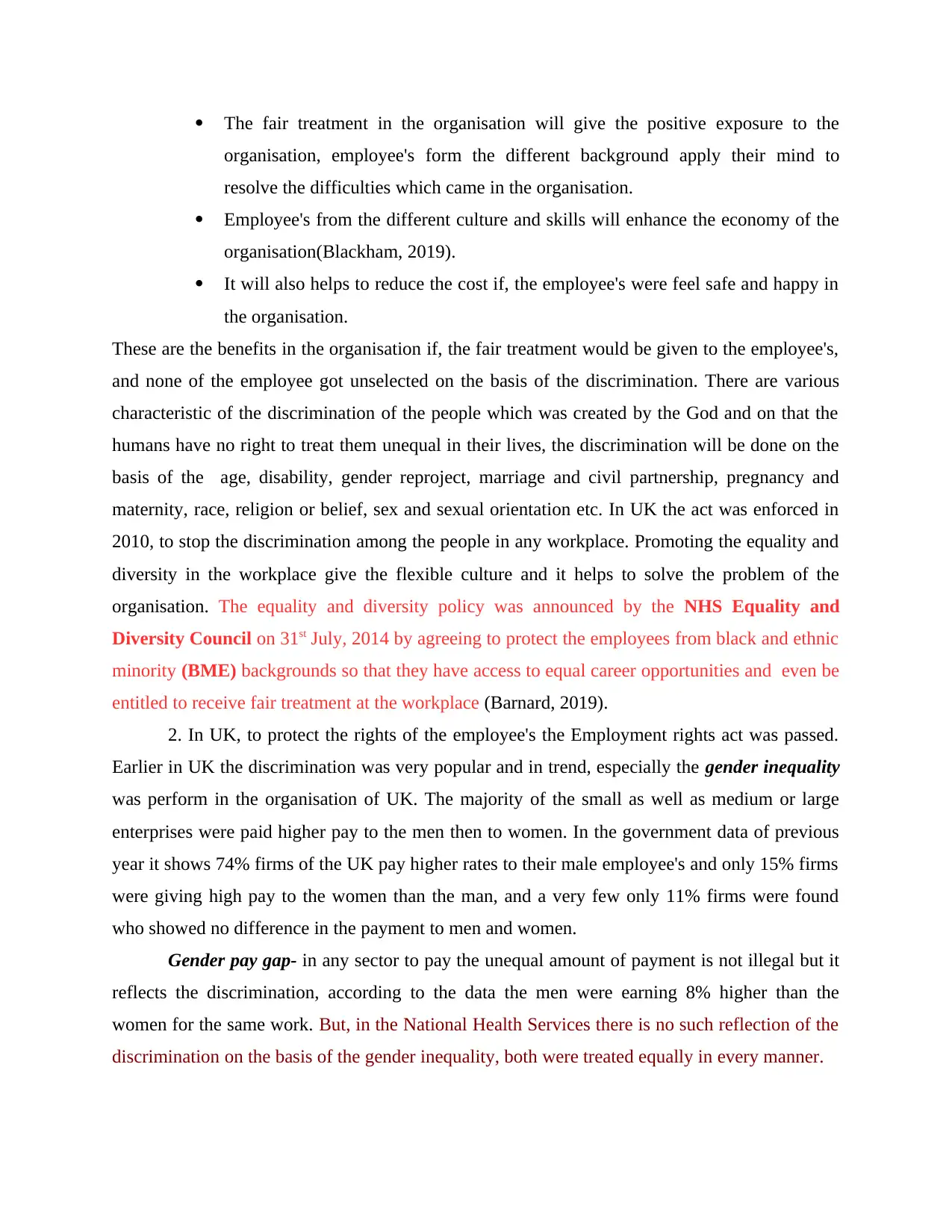
The fair treatment in the organisation will give the positive exposure to the
organisation, employee's form the different background apply their mind to
resolve the difficulties which came in the organisation.
Employee's from the different culture and skills will enhance the economy of the
organisation(Blackham, 2019).
It will also helps to reduce the cost if, the employee's were feel safe and happy in
the organisation.
These are the benefits in the organisation if, the fair treatment would be given to the employee's,
and none of the employee got unselected on the basis of the discrimination. There are various
characteristic of the discrimination of the people which was created by the God and on that the
humans have no right to treat them unequal in their lives, the discrimination will be done on the
basis of the age, disability, gender reproject, marriage and civil partnership, pregnancy and
maternity, race, religion or belief, sex and sexual orientation etc. In UK the act was enforced in
2010, to stop the discrimination among the people in any workplace. Promoting the equality and
diversity in the workplace give the flexible culture and it helps to solve the problem of the
organisation. The equality and diversity policy was announced by the NHS Equality and
Diversity Council on 31st July, 2014 by agreeing to protect the employees from black and ethnic
minority (BME) backgrounds so that they have access to equal career opportunities and even be
entitled to receive fair treatment at the workplace (Barnard, 2019).
2. In UK, to protect the rights of the employee's the Employment rights act was passed.
Earlier in UK the discrimination was very popular and in trend, especially the gender inequality
was perform in the organisation of UK. The majority of the small as well as medium or large
enterprises were paid higher pay to the men then to women. In the government data of previous
year it shows 74% firms of the UK pay higher rates to their male employee's and only 15% firms
were giving high pay to the women than the man, and a very few only 11% firms were found
who showed no difference in the payment to men and women.
Gender pay gap- in any sector to pay the unequal amount of payment is not illegal but it
reflects the discrimination, according to the data the men were earning 8% higher than the
women for the same work. But, in the National Health Services there is no such reflection of the
discrimination on the basis of the gender inequality, both were treated equally in every manner.
organisation, employee's form the different background apply their mind to
resolve the difficulties which came in the organisation.
Employee's from the different culture and skills will enhance the economy of the
organisation(Blackham, 2019).
It will also helps to reduce the cost if, the employee's were feel safe and happy in
the organisation.
These are the benefits in the organisation if, the fair treatment would be given to the employee's,
and none of the employee got unselected on the basis of the discrimination. There are various
characteristic of the discrimination of the people which was created by the God and on that the
humans have no right to treat them unequal in their lives, the discrimination will be done on the
basis of the age, disability, gender reproject, marriage and civil partnership, pregnancy and
maternity, race, religion or belief, sex and sexual orientation etc. In UK the act was enforced in
2010, to stop the discrimination among the people in any workplace. Promoting the equality and
diversity in the workplace give the flexible culture and it helps to solve the problem of the
organisation. The equality and diversity policy was announced by the NHS Equality and
Diversity Council on 31st July, 2014 by agreeing to protect the employees from black and ethnic
minority (BME) backgrounds so that they have access to equal career opportunities and even be
entitled to receive fair treatment at the workplace (Barnard, 2019).
2. In UK, to protect the rights of the employee's the Employment rights act was passed.
Earlier in UK the discrimination was very popular and in trend, especially the gender inequality
was perform in the organisation of UK. The majority of the small as well as medium or large
enterprises were paid higher pay to the men then to women. In the government data of previous
year it shows 74% firms of the UK pay higher rates to their male employee's and only 15% firms
were giving high pay to the women than the man, and a very few only 11% firms were found
who showed no difference in the payment to men and women.
Gender pay gap- in any sector to pay the unequal amount of payment is not illegal but it
reflects the discrimination, according to the data the men were earning 8% higher than the
women for the same work. But, in the National Health Services there is no such reflection of the
discrimination on the basis of the gender inequality, both were treated equally in every manner.
Paraphrase This Document
Need a fresh take? Get an instant paraphrase of this document with our AI Paraphraser
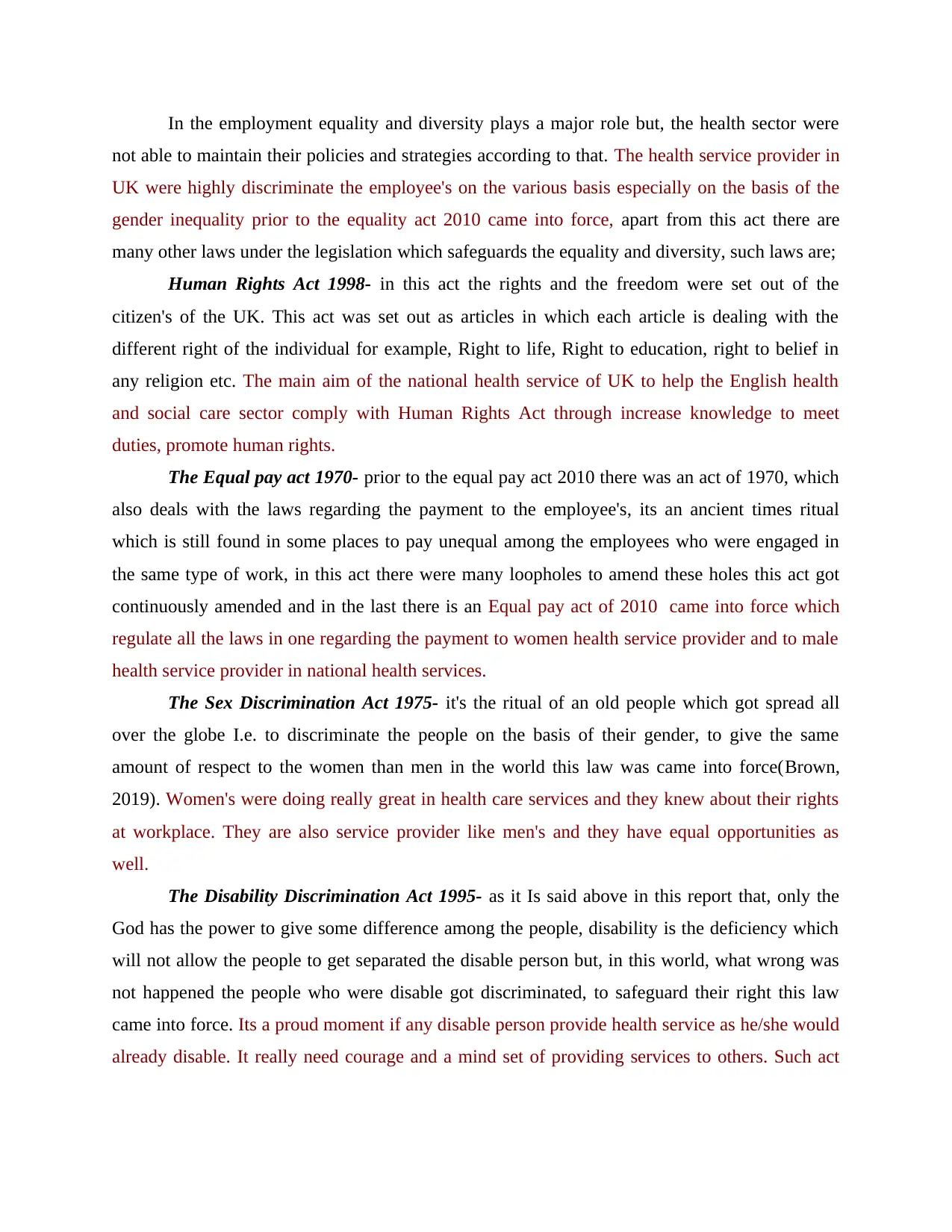
In the employment equality and diversity plays a major role but, the health sector were
not able to maintain their policies and strategies according to that. The health service provider in
UK were highly discriminate the employee's on the various basis especially on the basis of the
gender inequality prior to the equality act 2010 came into force, apart from this act there are
many other laws under the legislation which safeguards the equality and diversity, such laws are;
Human Rights Act 1998- in this act the rights and the freedom were set out of the
citizen's of the UK. This act was set out as articles in which each article is dealing with the
different right of the individual for example, Right to life, Right to education, right to belief in
any religion etc. The main aim of the national health service of UK to help the English health
and social care sector comply with Human Rights Act through increase knowledge to meet
duties, promote human rights.
The Equal pay act 1970- prior to the equal pay act 2010 there was an act of 1970, which
also deals with the laws regarding the payment to the employee's, its an ancient times ritual
which is still found in some places to pay unequal among the employees who were engaged in
the same type of work, in this act there were many loopholes to amend these holes this act got
continuously amended and in the last there is an Equal pay act of 2010 came into force which
regulate all the laws in one regarding the payment to women health service provider and to male
health service provider in national health services.
The Sex Discrimination Act 1975- it's the ritual of an old people which got spread all
over the globe I.e. to discriminate the people on the basis of their gender, to give the same
amount of respect to the women than men in the world this law was came into force(Brown,
2019). Women's were doing really great in health care services and they knew about their rights
at workplace. They are also service provider like men's and they have equal opportunities as
well.
The Disability Discrimination Act 1995- as it Is said above in this report that, only the
God has the power to give some difference among the people, disability is the deficiency which
will not allow the people to get separated the disable person but, in this world, what wrong was
not happened the people who were disable got discriminated, to safeguard their right this law
came into force. Its a proud moment if any disable person provide health service as he/she would
already disable. It really need courage and a mind set of providing services to others. Such act
not able to maintain their policies and strategies according to that. The health service provider in
UK were highly discriminate the employee's on the various basis especially on the basis of the
gender inequality prior to the equality act 2010 came into force, apart from this act there are
many other laws under the legislation which safeguards the equality and diversity, such laws are;
Human Rights Act 1998- in this act the rights and the freedom were set out of the
citizen's of the UK. This act was set out as articles in which each article is dealing with the
different right of the individual for example, Right to life, Right to education, right to belief in
any religion etc. The main aim of the national health service of UK to help the English health
and social care sector comply with Human Rights Act through increase knowledge to meet
duties, promote human rights.
The Equal pay act 1970- prior to the equal pay act 2010 there was an act of 1970, which
also deals with the laws regarding the payment to the employee's, its an ancient times ritual
which is still found in some places to pay unequal among the employees who were engaged in
the same type of work, in this act there were many loopholes to amend these holes this act got
continuously amended and in the last there is an Equal pay act of 2010 came into force which
regulate all the laws in one regarding the payment to women health service provider and to male
health service provider in national health services.
The Sex Discrimination Act 1975- it's the ritual of an old people which got spread all
over the globe I.e. to discriminate the people on the basis of their gender, to give the same
amount of respect to the women than men in the world this law was came into force(Brown,
2019). Women's were doing really great in health care services and they knew about their rights
at workplace. They are also service provider like men's and they have equal opportunities as
well.
The Disability Discrimination Act 1995- as it Is said above in this report that, only the
God has the power to give some difference among the people, disability is the deficiency which
will not allow the people to get separated the disable person but, in this world, what wrong was
not happened the people who were disable got discriminated, to safeguard their right this law
came into force. Its a proud moment if any disable person provide health service as he/she would
already disable. It really need courage and a mind set of providing services to others. Such act
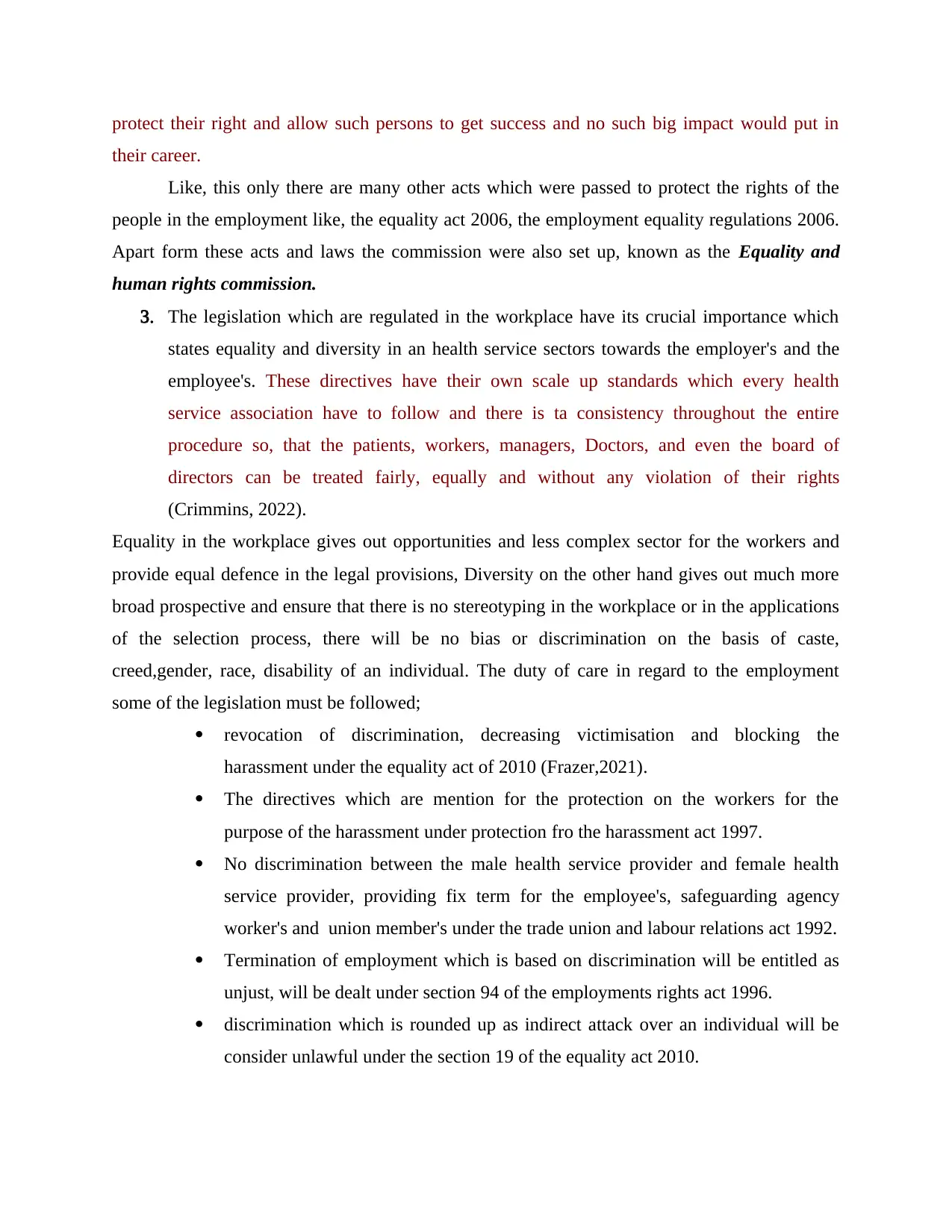
protect their right and allow such persons to get success and no such big impact would put in
their career.
Like, this only there are many other acts which were passed to protect the rights of the
people in the employment like, the equality act 2006, the employment equality regulations 2006.
Apart form these acts and laws the commission were also set up, known as the Equality and
human rights commission.
3. The legislation which are regulated in the workplace have its crucial importance which
states equality and diversity in an health service sectors towards the employer's and the
employee's. These directives have their own scale up standards which every health
service association have to follow and there is ta consistency throughout the entire
procedure so, that the patients, workers, managers, Doctors, and even the board of
directors can be treated fairly, equally and without any violation of their rights
(Crimmins, 2022).
Equality in the workplace gives out opportunities and less complex sector for the workers and
provide equal defence in the legal provisions, Diversity on the other hand gives out much more
broad prospective and ensure that there is no stereotyping in the workplace or in the applications
of the selection process, there will be no bias or discrimination on the basis of caste,
creed,gender, race, disability of an individual. The duty of care in regard to the employment
some of the legislation must be followed;
revocation of discrimination, decreasing victimisation and blocking the
harassment under the equality act of 2010 (Frazer,2021).
The directives which are mention for the protection on the workers for the
purpose of the harassment under protection fro the harassment act 1997.
No discrimination between the male health service provider and female health
service provider, providing fix term for the employee's, safeguarding agency
worker's and union member's under the trade union and labour relations act 1992.
Termination of employment which is based on discrimination will be entitled as
unjust, will be dealt under section 94 of the employments rights act 1996.
discrimination which is rounded up as indirect attack over an individual will be
consider unlawful under the section 19 of the equality act 2010.
their career.
Like, this only there are many other acts which were passed to protect the rights of the
people in the employment like, the equality act 2006, the employment equality regulations 2006.
Apart form these acts and laws the commission were also set up, known as the Equality and
human rights commission.
3. The legislation which are regulated in the workplace have its crucial importance which
states equality and diversity in an health service sectors towards the employer's and the
employee's. These directives have their own scale up standards which every health
service association have to follow and there is ta consistency throughout the entire
procedure so, that the patients, workers, managers, Doctors, and even the board of
directors can be treated fairly, equally and without any violation of their rights
(Crimmins, 2022).
Equality in the workplace gives out opportunities and less complex sector for the workers and
provide equal defence in the legal provisions, Diversity on the other hand gives out much more
broad prospective and ensure that there is no stereotyping in the workplace or in the applications
of the selection process, there will be no bias or discrimination on the basis of caste,
creed,gender, race, disability of an individual. The duty of care in regard to the employment
some of the legislation must be followed;
revocation of discrimination, decreasing victimisation and blocking the
harassment under the equality act of 2010 (Frazer,2021).
The directives which are mention for the protection on the workers for the
purpose of the harassment under protection fro the harassment act 1997.
No discrimination between the male health service provider and female health
service provider, providing fix term for the employee's, safeguarding agency
worker's and union member's under the trade union and labour relations act 1992.
Termination of employment which is based on discrimination will be entitled as
unjust, will be dealt under section 94 of the employments rights act 1996.
discrimination which is rounded up as indirect attack over an individual will be
consider unlawful under the section 19 of the equality act 2010.
⊘ This is a preview!⊘
Do you want full access?
Subscribe today to unlock all pages.

Trusted by 1+ million students worldwide
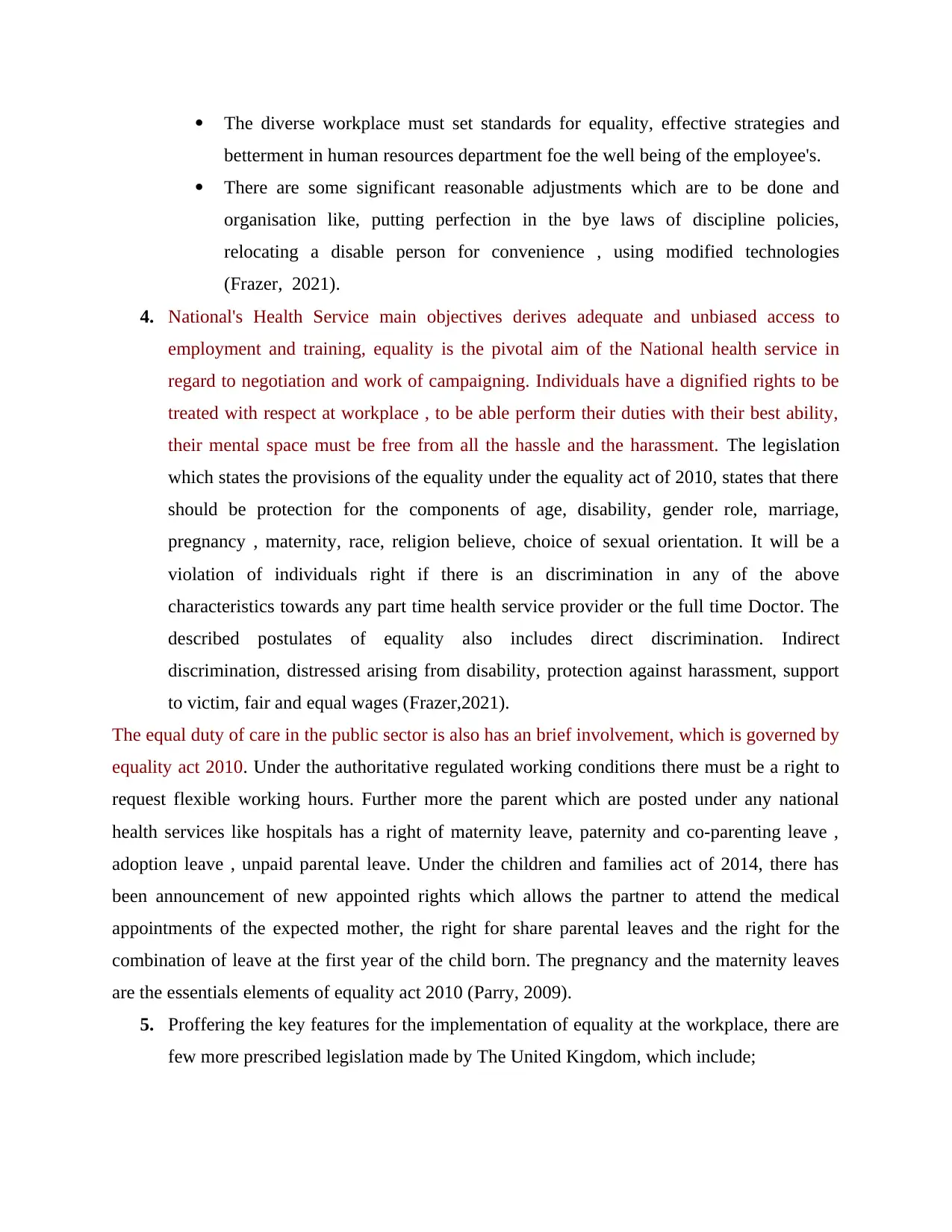
The diverse workplace must set standards for equality, effective strategies and
betterment in human resources department foe the well being of the employee's.
There are some significant reasonable adjustments which are to be done and
organisation like, putting perfection in the bye laws of discipline policies,
relocating a disable person for convenience , using modified technologies
(Frazer, 2021).
4. National's Health Service main objectives derives adequate and unbiased access to
employment and training, equality is the pivotal aim of the National health service in
regard to negotiation and work of campaigning. Individuals have a dignified rights to be
treated with respect at workplace , to be able perform their duties with their best ability,
their mental space must be free from all the hassle and the harassment. The legislation
which states the provisions of the equality under the equality act of 2010, states that there
should be protection for the components of age, disability, gender role, marriage,
pregnancy , maternity, race, religion believe, choice of sexual orientation. It will be a
violation of individuals right if there is an discrimination in any of the above
characteristics towards any part time health service provider or the full time Doctor. The
described postulates of equality also includes direct discrimination. Indirect
discrimination, distressed arising from disability, protection against harassment, support
to victim, fair and equal wages (Frazer,2021).
The equal duty of care in the public sector is also has an brief involvement, which is governed by
equality act 2010. Under the authoritative regulated working conditions there must be a right to
request flexible working hours. Further more the parent which are posted under any national
health services like hospitals has a right of maternity leave, paternity and co-parenting leave ,
adoption leave , unpaid parental leave. Under the children and families act of 2014, there has
been announcement of new appointed rights which allows the partner to attend the medical
appointments of the expected mother, the right for share parental leaves and the right for the
combination of leave at the first year of the child born. The pregnancy and the maternity leaves
are the essentials elements of equality act 2010 (Parry, 2009).
5. Proffering the key features for the implementation of equality at the workplace, there are
few more prescribed legislation made by The United Kingdom, which include;
betterment in human resources department foe the well being of the employee's.
There are some significant reasonable adjustments which are to be done and
organisation like, putting perfection in the bye laws of discipline policies,
relocating a disable person for convenience , using modified technologies
(Frazer, 2021).
4. National's Health Service main objectives derives adequate and unbiased access to
employment and training, equality is the pivotal aim of the National health service in
regard to negotiation and work of campaigning. Individuals have a dignified rights to be
treated with respect at workplace , to be able perform their duties with their best ability,
their mental space must be free from all the hassle and the harassment. The legislation
which states the provisions of the equality under the equality act of 2010, states that there
should be protection for the components of age, disability, gender role, marriage,
pregnancy , maternity, race, religion believe, choice of sexual orientation. It will be a
violation of individuals right if there is an discrimination in any of the above
characteristics towards any part time health service provider or the full time Doctor. The
described postulates of equality also includes direct discrimination. Indirect
discrimination, distressed arising from disability, protection against harassment, support
to victim, fair and equal wages (Frazer,2021).
The equal duty of care in the public sector is also has an brief involvement, which is governed by
equality act 2010. Under the authoritative regulated working conditions there must be a right to
request flexible working hours. Further more the parent which are posted under any national
health services like hospitals has a right of maternity leave, paternity and co-parenting leave ,
adoption leave , unpaid parental leave. Under the children and families act of 2014, there has
been announcement of new appointed rights which allows the partner to attend the medical
appointments of the expected mother, the right for share parental leaves and the right for the
combination of leave at the first year of the child born. The pregnancy and the maternity leaves
are the essentials elements of equality act 2010 (Parry, 2009).
5. Proffering the key features for the implementation of equality at the workplace, there are
few more prescribed legislation made by The United Kingdom, which include;
Paraphrase This Document
Need a fresh take? Get an instant paraphrase of this document with our AI Paraphraser
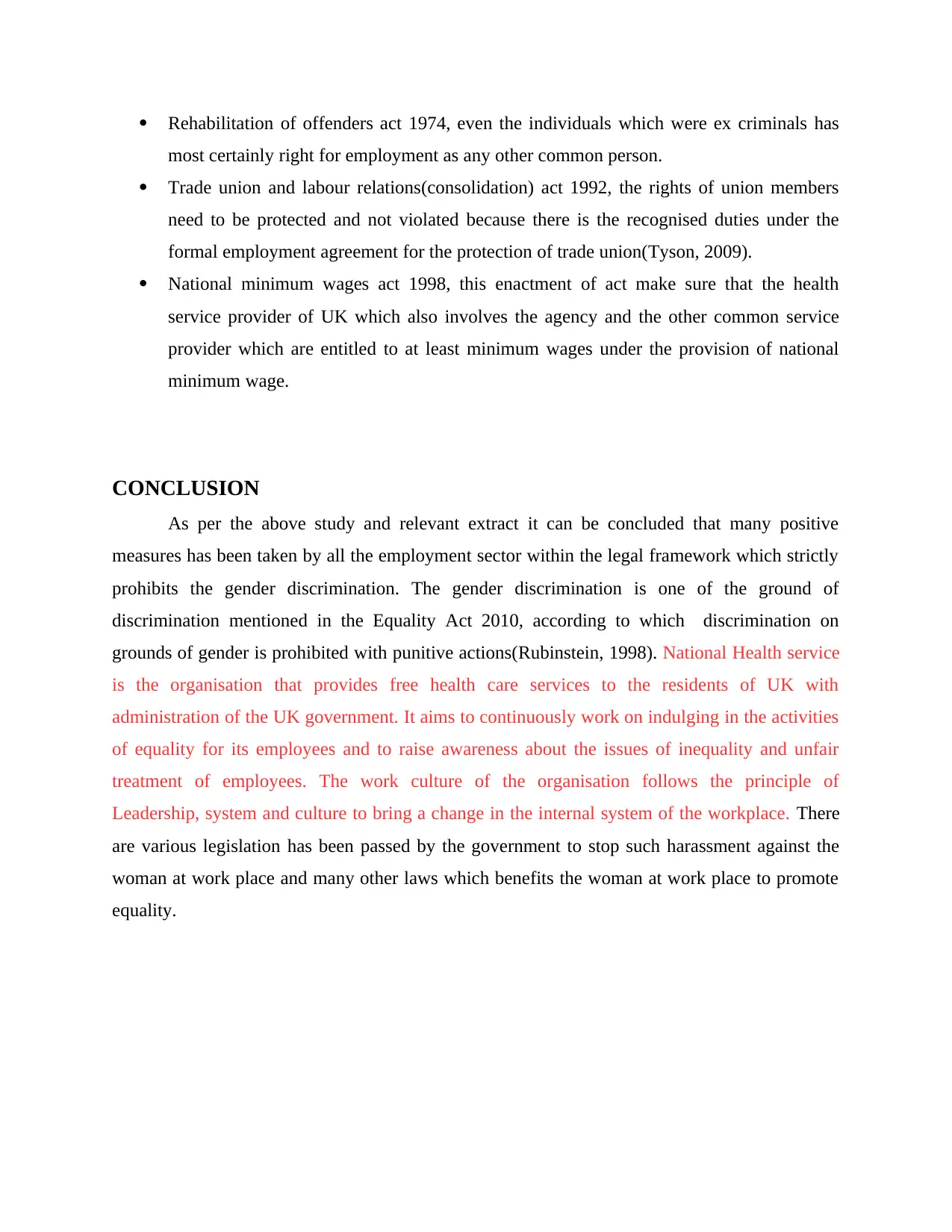
Rehabilitation of offenders act 1974, even the individuals which were ex criminals has
most certainly right for employment as any other common person.
Trade union and labour relations(consolidation) act 1992, the rights of union members
need to be protected and not violated because there is the recognised duties under the
formal employment agreement for the protection of trade union(Tyson, 2009).
National minimum wages act 1998, this enactment of act make sure that the health
service provider of UK which also involves the agency and the other common service
provider which are entitled to at least minimum wages under the provision of national
minimum wage.
CONCLUSION
As per the above study and relevant extract it can be concluded that many positive
measures has been taken by all the employment sector within the legal framework which strictly
prohibits the gender discrimination. The gender discrimination is one of the ground of
discrimination mentioned in the Equality Act 2010, according to which discrimination on
grounds of gender is prohibited with punitive actions(Rubinstein, 1998). National Health service
is the organisation that provides free health care services to the residents of UK with
administration of the UK government. It aims to continuously work on indulging in the activities
of equality for its employees and to raise awareness about the issues of inequality and unfair
treatment of employees. The work culture of the organisation follows the principle of
Leadership, system and culture to bring a change in the internal system of the workplace. There
are various legislation has been passed by the government to stop such harassment against the
woman at work place and many other laws which benefits the woman at work place to promote
equality.
most certainly right for employment as any other common person.
Trade union and labour relations(consolidation) act 1992, the rights of union members
need to be protected and not violated because there is the recognised duties under the
formal employment agreement for the protection of trade union(Tyson, 2009).
National minimum wages act 1998, this enactment of act make sure that the health
service provider of UK which also involves the agency and the other common service
provider which are entitled to at least minimum wages under the provision of national
minimum wage.
CONCLUSION
As per the above study and relevant extract it can be concluded that many positive
measures has been taken by all the employment sector within the legal framework which strictly
prohibits the gender discrimination. The gender discrimination is one of the ground of
discrimination mentioned in the Equality Act 2010, according to which discrimination on
grounds of gender is prohibited with punitive actions(Rubinstein, 1998). National Health service
is the organisation that provides free health care services to the residents of UK with
administration of the UK government. It aims to continuously work on indulging in the activities
of equality for its employees and to raise awareness about the issues of inequality and unfair
treatment of employees. The work culture of the organisation follows the principle of
Leadership, system and culture to bring a change in the internal system of the workplace. There
are various legislation has been passed by the government to stop such harassment against the
woman at work place and many other laws which benefits the woman at work place to promote
equality.
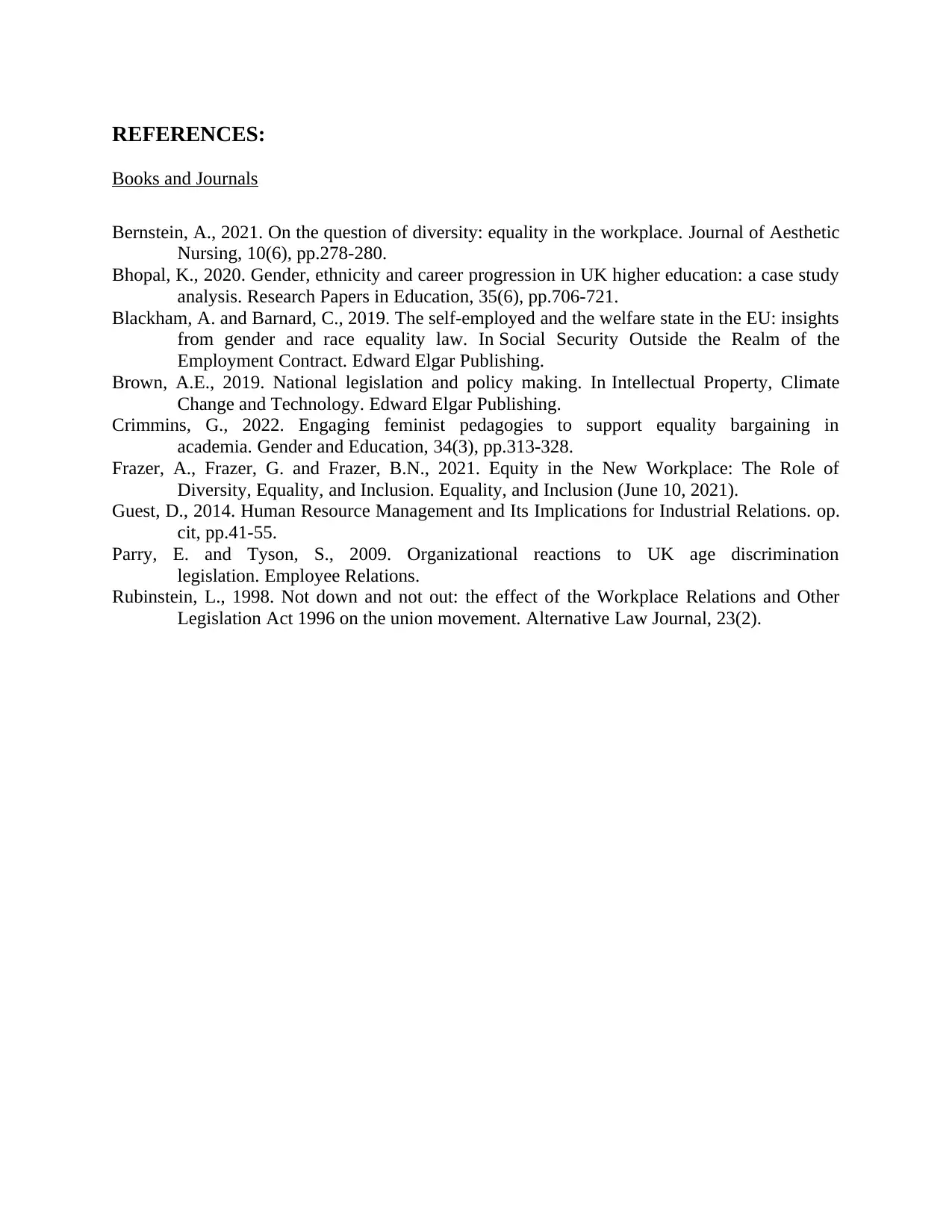
REFERENCES:
Books and Journals
Bernstein, A., 2021. On the question of diversity: equality in the workplace. Journal of Aesthetic
Nursing, 10(6), pp.278-280.
Bhopal, K., 2020. Gender, ethnicity and career progression in UK higher education: a case study
analysis. Research Papers in Education, 35(6), pp.706-721.
Blackham, A. and Barnard, C., 2019. The self-employed and the welfare state in the EU: insights
from gender and race equality law. In Social Security Outside the Realm of the
Employment Contract. Edward Elgar Publishing.
Brown, A.E., 2019. National legislation and policy making. In Intellectual Property, Climate
Change and Technology. Edward Elgar Publishing.
Crimmins, G., 2022. Engaging feminist pedagogies to support equality bargaining in
academia. Gender and Education, 34(3), pp.313-328.
Frazer, A., Frazer, G. and Frazer, B.N., 2021. Equity in the New Workplace: The Role of
Diversity, Equality, and Inclusion. Equality, and Inclusion (June 10, 2021).
Guest, D., 2014. Human Resource Management and Its Implications for Industrial Relations. op.
cit, pp.41-55.
Parry, E. and Tyson, S., 2009. Organizational reactions to UK age discrimination
legislation. Employee Relations.
Rubinstein, L., 1998. Not down and not out: the effect of the Workplace Relations and Other
Legislation Act 1996 on the union movement. Alternative Law Journal, 23(2).
Books and Journals
Bernstein, A., 2021. On the question of diversity: equality in the workplace. Journal of Aesthetic
Nursing, 10(6), pp.278-280.
Bhopal, K., 2020. Gender, ethnicity and career progression in UK higher education: a case study
analysis. Research Papers in Education, 35(6), pp.706-721.
Blackham, A. and Barnard, C., 2019. The self-employed and the welfare state in the EU: insights
from gender and race equality law. In Social Security Outside the Realm of the
Employment Contract. Edward Elgar Publishing.
Brown, A.E., 2019. National legislation and policy making. In Intellectual Property, Climate
Change and Technology. Edward Elgar Publishing.
Crimmins, G., 2022. Engaging feminist pedagogies to support equality bargaining in
academia. Gender and Education, 34(3), pp.313-328.
Frazer, A., Frazer, G. and Frazer, B.N., 2021. Equity in the New Workplace: The Role of
Diversity, Equality, and Inclusion. Equality, and Inclusion (June 10, 2021).
Guest, D., 2014. Human Resource Management and Its Implications for Industrial Relations. op.
cit, pp.41-55.
Parry, E. and Tyson, S., 2009. Organizational reactions to UK age discrimination
legislation. Employee Relations.
Rubinstein, L., 1998. Not down and not out: the effect of the Workplace Relations and Other
Legislation Act 1996 on the union movement. Alternative Law Journal, 23(2).
⊘ This is a preview!⊘
Do you want full access?
Subscribe today to unlock all pages.

Trusted by 1+ million students worldwide
1 out of 9
Related Documents
Your All-in-One AI-Powered Toolkit for Academic Success.
+13062052269
info@desklib.com
Available 24*7 on WhatsApp / Email
![[object Object]](/_next/static/media/star-bottom.7253800d.svg)
Unlock your academic potential
Copyright © 2020–2025 A2Z Services. All Rights Reserved. Developed and managed by ZUCOL.




